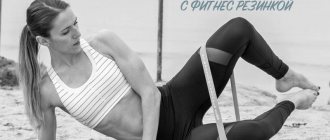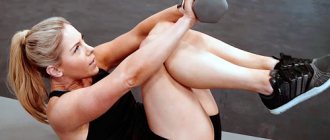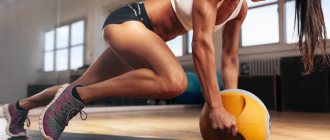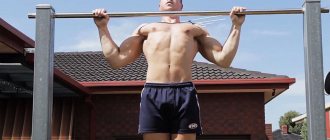Fullbody is a type of training program that works all of the athlete's major muscle groups (the whole body) in one workout. The proven effectiveness of the fullbody on muscle growth and strength indicators makes it number one in the training system for a novice bodybuilder or strength officer.
All training programs for building muscle, which generally exist in gyms, can be divided into two main types:
- split (splitting muscle groups by training days)
- fullbody (working the whole body in one workout)
Both training systems have their disadvantages and advantages . Our task is to choose the optimal training program for you, based on your level of athletic training and goals in the gym.
What is better split or fullbody training?
The training program, which pumps up the entire body in one session, is recognized by American scientists as better (Strength and Conditioning Research) compared to traditional split training, for beginners who want to increase muscle mass and strength.
However, until now, many illiterate trainers try to divide the training of muscle groups on different days for beginners, based on their pseudo beliefs .
Common mistakes of fitness trainers who do not recognize the full body are:
- multiple repetitions of exercises performed
- having a lot of exercises
- very frequent hard workouts
Naturally, with this approach to fullbody training, the athlete will get nothing but overtraining . Therefore, when developing a training program using this system, it is necessary to adhere to the following principles:
- Microperiodization of the training process.
- Working range of working weight – no more than 5 approaches, number of repetitions no more than 12.
- Focus on basic exercises: barbell squats, bench presses and deadlifts.
- Isolation exercises should be few in number and performed with light to moderate weights without excessive muscle fatigue.
- The workout should not last 45 minutes, as many people write, but 1.5-2 hours , this is exactly how much time will need to be spent in the gym in order to complete all the exercises fully, without rushing, with the correct technique, while giving 100% , and not like many "libs to do".
A properly designed fullbody program can transform the entire body of a beginner beyond recognition in the shortest possible time.
Split training is not as effective for beginners, but experienced athletes and professionals . Because the working weights in the exercises are very high relative to the beginner level of the athlete, and it is difficult for the body to constantly train with heavy weights. A way out of this situation is to train muscle groups on different days , for example, on
- Monday you train chest/biceps
- Tuesday – shoulders/calves
- Thursday – back/triceps
- Friday – thighs/abs
Which is better, split or fullbody training
or a three-day split system:
- Monday – triceps/back/deltoids/abs
- Wednesday – biceps/forearm/chest/abs
- Friday – legs/abs)
medium in your fullbody program .
We recommend that all advanced athletes and pros train using both methods , both split and fullbody, and experimentally determine which one works best for you.
In order to objectively evaluate and draw appropriate conclusions about better muscle growth, you need to regularly train in a split or full body for at least half a year .
For athletes who are involved in powerlifting or simply want to increase their strength in some basic exercises, the choice should fall on the fullbody. Because it is this system, with its microcycles in the form of alternating light, medium and heavy training in the base, that is ideal for quickly increasing strength.
All strength athletes should remember that additional isolation exercises waste the body’s precious energy resources , and as a result, the recovery time between workouts increases because of this.
Despite this, many people continue to train with a break of 1-2 days , and as a result, over time, the athlete “catches” overtraining. Therefore, decide what is more important for you: muscle growth and working with light weights or increasing strength in basic exercises.
The basis of the fullbody program is the basic exercises (squat, deadlift, press), while in split training each exercise (basic and isolating) makes a significant contribution to the development of all muscle groups. Hence there are so many different opinions about the effectiveness of fullbody programs and split training.
Squats
General principles of the 8-week program for beginners
- Do one exercise for each major muscle group.
- Spend the first two weeks mastering the technique; the working weight should be light. Use additional sets to hone your movement technique.
- In the third and fourth weeks, add one set at a time. Start with a light warm-up set, then gradually increase the weight over the next two sets. You must achieve muscle failure through the planned number of repetitions. Don't sacrifice technique in the name of cranking up your rep count if the weight is too heavy. As you can imagine, muscle failure occurs when you cannot perform a movement as described in textbooks.
- Start with a light warm-up set during the third phase (weeks 5-8), then add serious weight for the second and third sets. Try to choose a weight with which you can only complete the target number of repetitions. If you can do more reps, the weight needs to be understood. If you can't reach the target, the weight is too heavy.
- Over time, you will get stronger and will need to do more repetitions and/or increase the load to provide adequate stimulation to the target muscles.
- If an exercise with dumbbells or a barbell seems too difficult, find an analogue on the machine, practice, and then return to the exercise with free weights.
- Do this program three times a week with a mandatory rest day between workouts (for example, Monday, Wednesday and Friday).
Fullbody training program
We present to you an effective fullbody training program for building muscle mass and increasing strength. It is universal, suitable for both beginners and experienced athletes or professionals.
1 WEEK
Monday
- Squats with a barbell 3x12 (60-65%*)
- Bench press 5x6 (75-80%)
- Lying dumbbell flyes 3x12
- Barbell curl 4x8
- Press crunches 2x50
Wednesday
- Deadlift 5x6 (75-80%)
- Bench press 3x12 (60-65%)
- Dips (with weights) 4x8
- Standing dumbbell biceps curl 3x12
- Raising legs bent at the knees to press 4x15
Friday
- Squats with barbell 4x8 (70-75%)
- Bench press 4x4 (80-85%)
- Pull-up on the bar 4x8 (with weights)
- Arnold Press 4x8
- Press crunches 2x50
WEEK 2
Monday
- Deadlift 3x12 (60-65%)
- Bench press 4x8 (70-75%)
- French bench press 3x12
- Information in the 4x8 butterfly simulator
- Standing biceps curl 5x6
- Press crunches 2x50
Wednesday
- Squats with barbell 4x8 (70-75%)
- Bench press 5x6 (75-80%)
- Standing barbell press 4x8
- Press to the bottom in a 3x12 block machine
- Raising the EZ-bar for biceps in a Scott bench 4x8
- Straight leg raise for press 4x12
Friday
- Deadlift 5x6 (75-80%)
- Bench press 3x12 (60-65%)
- Vertical block row (lat) 3x12
- Dumbbell flyes lying on a 4x8 bench
- Standing biceps curl 3x12
- Press crunches 2x50
WEEK 3
Fullbody training program
Monday
- Squats with barbell 4x8 (70-75%)
- Bench press 4x4 (80-85%)
- Close grip bench press 4x8 (70-75%)
- Standing dumbbell press 3x12
- Standing dumbbell raises 4x8
- Seated dumbbell biceps curl 4x8
- Hanging bent leg raises (knees) 4x15
Wednesday
- Deadlift 3x12 (60-65%)
- Bench press 4x8 (70-75%)
- Press at an angle of 45 degrees 4x8 (70-75%)
- Lying dumbbell flyes 3x12
- French standing barbell press 4x8
- Lifting dumbbells for biceps in a Scott bench 4x8
- Press crunches 2x50
Friday
- Squats with barbell 4x4 (80-85%)
- Bench press 5x6 (75-80%)
- Dips 4x8
- Pull-ups on the bar (with weights) 4x8
- Raising legs bent at the knees while hanging on a 4x12 bar
WEEK 4
Monday
- Deadlift 4x8 (70-75%)
- Bench press 3x12 (60-65%)
- Dumbbell bench press 4x8
- Standing dumbbell biceps curl 3x12
- Hammer 4x8
- Press crunches 2x50
Wednesday
- Squats with a barbell 3x12 (60-65%)
- Bench press 4x4 (80-85%)
- Dips 4x8
- Lying dumbbell flyes 3x12
- Pull-up on the bar (with weights) 5x6
- Raising straight legs while hanging on a 4x12 bar
Friday
- Deadlift 4x4 (80-85%)
- Bench press 3x12 (60-65%)
- Seated barbell press 5x6 (75-80%)
- 4x8 Dumbbell Side Raise
- Standing biceps curl 3x12
- Press crunches 2x50
download this training program with comments from the link below.
Downloads: 4892, size: 452.1 KB, date: 12 Jun. 2018
*The weight of the maximum is indicated as a percentage ( % ).
The training will take place at the following intensity (depending on the working weight in the basic exercises):
- 60-65% - light
- 70-75% - average
- 75-80% - above average
- 80-85% - heavy
Auxiliary exercises are included in order to diversify the fullbody training program. Don’t try to get overly tired when doing them, do them “for your own pleasure.” all your power and energy when performing basic exercises for the main muscle groups, that is, in the squat, deadlift, and press.
Tough attitude in training
The cycle consists of 4 weeks , which is repeated again after the last week has passed.
All the main time in training will be spent on performing the main (basic) exercises - squats with a barbell, deadlifts, and bench presses. In each approach, try to give your best , if the workout is easy or medium, try to work more on technique .
do pull-ups without additional burden (weight), if this is difficult for you.
As you progress through the program, your strength results will increase , followed by muscle mass. Do not chase heavy weights, increase the weight on the bar gradually ( 2.5-5 kg in no more than 1-2 weeks).
You don’t have to do the deadlift if you have problems with the spine , or simply don’t have the desire to do it, then in this case, turn on hyperesthesia to strengthen the back muscles, and also on the day when there was a deadlift, replace it with squats with a barbell, respectively, if the deadlift is heavy then heavy squats, if light, then light.
However, we advise beginner athletes not to eliminate the deadlift, since at the initial stage, this exercise is the most effective in gaining muscle mass and strength, and also allows you to feel to a greater extent the mental connection between the muscle and the brain, since it involves almost all muscles in body.
Traditionally, we start training after a thorough warm-up , then move on to the main basic and isolating exercises.
Cool down after training in the gym
At the end of the workout, be sure to do a cool-down, follow the link, you will see a set of exercises for stretching muscles, you need to choose only those that specifically act on the muscles that you trained (for example, if you did squats with a barbell on Monday, then stretching the back surface of the thigh and quadriceps is required), and also do not forget to hang on the horizontal bar to straighten the spinal discs and unload the back, for a speedy recovery.
Advantages
Benefits of Fulbadi training:
- Ideal for beginners. Helps properly prepare the body for more serious physical activity and recover after a long break.
- Both men and women of any age can train effectively.
- Fullbody can also be practiced by professional bodybuilders in the off-season to maintain “working” physical shape.
- High-quality work out of each muscle without injury and excessive workload.
- Quickly get rid of extra pounds (weight loss exercises).
- A safe method of strengthening not only the muscles of the whole body, but also the ligaments.
Interesting fact. Fulbadi is not suitable for experienced athletes who need constant progress. In this case, strength training or split programs will be most effective.
What are the benefits of full body training?
The advantage of the fullbody over other training programs is that it does not allow the body to adapt to the load (training stress), due to the constantly changing number of repetitions (working weight in the exercises), that is, alternating light/medium/heavy training.
At the same time, other training programs that are practiced by athletes in gyms often go to extremes , as a result of which the athlete either does not receive enough training stress or falls into overtraining. A well-designed fullbody eliminates these extremely negative aspects for muscle growth and strength.
If you find an error, please select a piece of text and press Ctrl+Enter.
Who is this program for?
Nowadays it is very fashionable to have a beautiful figure and more and more people are starting to go to gyms.
A beginner faces a big question: where to start? Many rush to pump up their biceps - considering that it is very fashionable, others exclusively load the chest muscles. In addition to beginners, the problem of choosing a workout faces those who go to the gym seasonally - for example, to pump up muscles before the beach season.
Many people don’t understand what exercises to do, what exercise machine to grab: the basic rule they follow is “grab what’s not occupied and lift it!” Without observing any systematics, beginners perform all the exercises they know in random order. But, unfortunately, such training does not bring results, and very soon the novice bodybuilder will be disappointed - the training goes on, but there is still no result!
It's good that you came to our site! Using our workouts compiled by professionals, you will progress and avoid making typical beginner mistakes.
Both for a beginner and for someone who has worked out before, but for some reason took a long break (a month or more), it is necessary to prepare the muscles for further increasing loads. This workout is perfect for this – fullbody. As you probably already understood from the name, this program is for the muscles of the whole body, and its main feature is that we will load all the muscles of the body in one workout.










